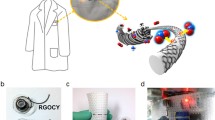Abstract
This paper presents flexible explosive sensors possibly manufacturable using high volume techniques. The flexible sensors were created using channel circuit electrodes (CCE) coated with hydrazinium graphene (HG) by a sprayer. The channel circuits produced using paste fill of fine traces is a simple yet largely unreported technique for creating electrodes. The CCE were prepared by molding electrode patterns into resin and filling the channels with conductive paste, producing trace widths of 100 µm and thickness of 4 µm. Its resistance was 5–10 kΩ/each electrode of 60 cm long in serpentine shape. Sensors created using HG as the resistive layer on CCE showed their ability to detect 18.1 ppb of Dinitrotoluene 2,4 (DNT), a precursor to trinitrotoluene (TNT). To form a complete package, resistive type sensors could be made into a portable detection system using simple electronics; we demonstrated the system with battery powered portable electronics.










Similar content being viewed by others
References
Moore, D. S. (2004). Instrumentation for trace detection of high explosives. Review of Scientific Instruments, 75, 2499–2512.
Bae, S., Kim, H., Lee, Y., Xu, X., Park, J., et al. (2010). Roll-to-roll production of 30-inch graphene films for transparent electrodes. Nature Nanotechnology, 5, 574–578.
Søndergaard, R., Hösel, M., Angmo, D., Larsen-Olsen, T. T., & Krebs, F. C. (2012). Roll-to-roll fabrication of polymer solar cells. Materials Today, 15, 36–49.
Krebs, F. C., Gevorgyan, S. A., & Alstrup, J. (2009). A roll-to-roll process to flexible polymer solar cells: Model studies, manufacture and operational stability studies. Journal of Materials Chemistry, 19, 5442–5451.
Gilleo, K. (2019). The circuit centennial. Retrieved December 13, 2019 from https://www.nonstopsystems.com/radio/pdf-hell/article-gilleo-03.pdf.
Stepan, W. E. (1985). Method of producing fine line conductive/resistive patterns on an insulating coating. U. S. Patent, 4508753.
Acikgoz, C., Hempenius, M. A., Huskens, J., & Vancso, G. J. (2011). Polymers in conventional and alternative lithography for the fabrication of nanostructures. European Polymer Journal, 47, 2033–2052.
Novoselov, K. S., Geim, A. K., Morozov, S. V., et al. (2004). Electric Field effect in atomically thin carbon films. Science, 306, 666–669.
Geim, A. K., & Novoselov, K. S. (2007). The rise of graphene. Nature Materials, 6, 183–191.
Allen, M. J., Tung, V. C., & Kaner, R. B. (2010). Honeycomb carbon: A review of graphene. Chemical Reviews, 110, 132–145.
Zhang, Y., Tan, Y.-W., Stormer, H. L., & Kim, P. (2005). Experimental observation of the quantum Hall effect and Berry’s phase in graphene. Nature, 438, 201–204.
Zhu, Y., Murali, S., Cai, W., Li, X., Suk, J. W., Potts, J. R., et al. (2010). Graphene and graphene oxide: Synthesis, properties, and applications. Advanced Materials, 22(35), 3906–3924.
Dan, Y., Lu, Y., Kybert, N. J., Luo, Z., & Johnson, A. T. C. (2009). Intrinsic response of graphene vapor sensors. Nano Letters, 9, 1472–1475.
Robinson, J. T., Perkins, K. F., Snow, E. S., Wei, Z., & Sheehan, P. E. (2008). Reduced graphene oxide molecular sensors. Nano Letters, 8, 3137–3140.
Moseley, P. T. (1997). Solid state gas sensors. Measurement Science & Technology, 8, 223–237.
Capone, S., et al. (2003). Solid state gas sensors: state of the art and future activities. Journal of Optoelectronics and Advanced Materials, 5, 1335–1348.
Kong, J., et al. (2000). Nanotube molecular wires as chemical sensors. Science, 287, 622–625.
Collins, P. G., Bradley, K., Ishigami, M., & Zettl, A. (2000). Extreme oxygen sensitivity of electronic properties of carbon nanotubes. Science, 287, 1801–1804.
Novoselov, K. S., et al. (2005). Two dimensional atomic crystals. Proceedings of National Academy of Sciences, 102(30), 10451–10453.
Novoselov, K. S., et al. (2005). Two dimensional gas of massless Dirac fermions in graphene. Nature, 438, 197–200.
Wehling, T. O., Novoselov, K. S., Morozov, S. V., Vdovin, E. E., Katsnelson, M. I., Geim, A. K., et al. (2008). Molecular doping of graphene. Nano Letters, 8(1), 173–177.
Leenaerts, O., Partoens, B., & Peeters, F. M. (2008). Adsorption of H2O, NH3, CO, NO2, and NO on graphene: A first-principles study. Physical Review B, 77, 125416.
Zhang, J., Boyd, A., Tselev, A., Paranjape, M., & Barbara, P. (2006). Mechanism of NO2 detection in carbon nanotube field effect transistor chemical sensors. Applied Physics Letters, 88, 123112.
Fowler, J. D., Allen, M. J., Tung, V. C., Yang, Y., Kaner, R. B., & Weiller, B. H. (2009). Practical chemical sensors from chemically derived graphene. ACS Nano, 3, 301–306.
Schedin, F., Geim, A. K., et al. (2007). Detection of individual gas molecules adsorbed on graphene. Nature Materials, 6, 652–655.
Hummers, W. S., & Offeman, R. E. (1958). Preparation of graphitic oxide. Journal of the American Chemical Society, 80, 1339.
Rosencrance, A. B., & Brueggemann, E. E. (1993). Experimental method for determination of the rate of evaporation of 2,4,6-trinitrotoluene (TNT) and 2,4dinitrotoluene (2,4-DNT). Technical report, U.S. Army Biomedical Research and Development Laboratory, Fort Detrick, Frederick, MD 21702-5010, June 1993.
Lee, K., Yoo, Y. K., Chae, M., et al. (2019). Highly selective reduced graphene oxide (rGO) sensor based on a peptide aptamer receptor for detecting explosives. Scientific Reports, 9, 10297.
Chae, M.-S., et al. (2015). A micro-preconcentrator combined olfactory sensing system with a micromechanical cantilever sensor for detecting 2,4-dinitrotoluene gas vapor. Sensors, 15(8), 18167–18177.
Acknowledgements
This work was supported in part by Grant NRF-2018R1A6A1A03025526 under the Priority Research Program through National Research Foundation of Korea(NRF) under Ministry of Education and the Education and Research Promotion Program of KOREATECH in 2019.
Author information
Authors and Affiliations
Corresponding author
Additional information
Publisher's Note
Springer Nature remains neutral with regard to jurisdictional claims in published maps and institutional affiliations.
Electronic supplementary material
Below is the link to the electronic supplementary material.
Supplementary material 1 (MP4 38946 kb)
Rights and permissions
About this article
Cite this article
Green, S., Song, S. & Kim, B. Fabrication of Channel Circuit Electrodes and Flexible Graphene Resistive Sensors for Detecting Dinitrotoluene 2,4 (DNT). Int. J. Precis. Eng. Manuf. 21, 1943–1953 (2020). https://doi.org/10.1007/s12541-020-00391-z
Received:
Revised:
Accepted:
Published:
Issue Date:
DOI: https://doi.org/10.1007/s12541-020-00391-z




